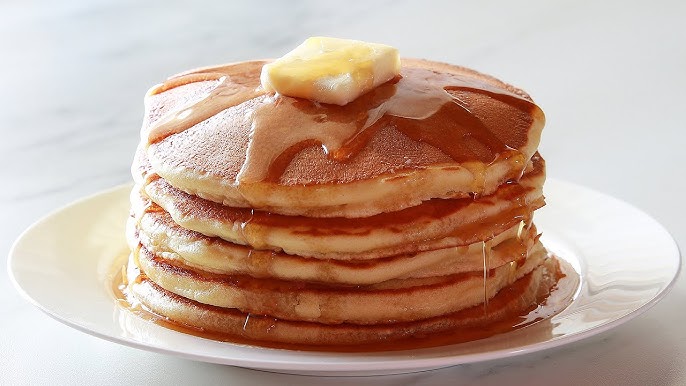Fluffy Pancakes Recipe: Who doesn’t love waking up to a plate of warm, fluffy pancakes? They’re the epitome of comfort food, perfect for breakfast, brunch, or even as a treat any time of the day.
The secret to achieving that perfect fluffiness lies in the right balance of ingredients, proper mixing, and a little patience.
Let’s dive into this easy step-by-step guide to making the fluffiest pancakes ever!
Ingredients for Fluffy Pancakes
Essential Dry Ingredients
To start, gather your dry ingredients:
- All-purpose flour: This is the base for your batter and provides structure.
- Baking powder and baking soda: These leavening agents are crucial for creating air pockets that make pancakes rise.
- Sugar: Adds a hint of sweetness to your pancakes.
- Salt: Enhances the overall flavor.
Essential Wet Ingredients
- Milk or buttermilk: Buttermilk gives a slight tang and helps with fluffiness. Regular milk works too.
- Eggs: They bind the batter together and add richness.
- Melted butter or oil: Ensures moist, tender pancakes.
- Vanilla extract: Adds a lovely aroma and subtle flavor.
Tools You’ll Need
You don’t need fancy equipment, just the basics:
- Mixing bowls: For separating wet and dry ingredients.
- Whisk and spatula: To mix and handle the batter.
- Measuring cups and spoons: To ensure the right proportions.
- Griddle or non-stick pan: For even cooking.
Preparing the Batter
Mixing Dry Ingredients
In a large bowl, sift together the flour, baking powder, sugar, and salt. Sifting ensures a smooth batter without lumps.
Mixing Wet Ingredients
In another bowl, whisk together milk, eggs, melted butter, and vanilla extract until fully combined. The melted butter adds richness and flavor.
Combining Wet and Dry Ingredients
Pour the wet mixture into the dry ingredients. Using a spatula or a whisk, mix until just combined. Lumps are okay—overmixing will make your pancakes dense instead of fluffy.
Heating the Pan or Griddle
Set your pan or griddle to medium heat. A consistent temperature is crucial. Test the heat by sprinkling a few drops of water—if they sizzle and evaporate, you’re ready to cook.
Cooking the Pancakes
Pouring the Batter
Using a ladle or measuring cup, pour a portion of batter onto the pan. Aim for about ¼ cup per pancake for a standard size. Leave enough space between pancakes for easy flipping.
Flipping the Pancakes
Look for bubbles forming on the surface and edges that start to set. These are signs it’s time to flip. Cook for another 1-2 minutes until golden brown.
Serving Suggestions
Classic Toppings
Keep it simple with a pat of butter, a drizzle of maple syrup, and a dusting of powdered sugar.
Creative Toppings
Take your pancakes to the next level with fresh fruits like strawberries and bananas, whipped cream, or even a sprinkle of chocolate chips.
Tips for the Best Fluffy Pancakes
- Use buttermilk for extra rise and flavor.
- Let the batter rest for 5-10 minutes before cooking to allow the baking powder to activate.
- Avoid overmixing the batter; it can lead to tough pancakes.
Storing and Reheating Pancakes
Short-term Storage
If you’re making a large batch, keep your pancakes warm in the oven. Preheat it to 200°F (95°C), place the pancakes on a baking sheet in a single layer, and cover them with aluminum foil to prevent them from drying out.
Long-term Storage
To store pancakes for later:
- Let them cool completely.
- Stack pancakes with parchment paper in between to prevent sticking.
- Place them in an airtight container or freezer bag and freeze for up to 3 months.
Reheating Tips
For the best results when reheating:
- Use a toaster for crispy edges.
- Microwave for 15-20 seconds for quick results.
- Reheat in a 350°F (175°C) oven for 5-7 minutes for a batch.
Variations of Fluffy Pancakes
Gluten-Free Pancakes
Swap out all-purpose flour for gluten-free flour blends. Almond flour or oat flour are excellent substitutes. Just ensure you use a binder like xanthan gum to maintain structure.
Vegan Pancakes
Replace eggs with a flax or chia egg (1 tablespoon flaxseed meal or chia seeds + 2.5 tablespoons water). Use almond milk or soy milk, and substitute butter with coconut oil.
Protein Pancakes
Boost your pancake game by adding protein powder, Greek yogurt, or nut butter. These ingredients not only enhance flavor but also make pancakes more filling.
Troubleshooting Common Pancake Problems
Why Are My Pancakes Flat?
Flat pancakes may result from old baking powder, overmixing the batter, or skipping buttermilk. Fresh ingredients and gentle mixing are key.
Why Are My Pancakes Unevenly Cooked?
An unevenly heated pan can cause this. Always preheat your pan or griddle and maintain consistent heat.
What If My Batter Is Too Thick or Runny?
- If it’s too thick, add a tablespoon of milk at a time until it reaches the desired consistency.
- If too runny, add a little flour.
Fun Pancake Facts
- Pancakes date back over 30,000 years to prehistoric times.
- Different cultures have unique pancake varieties, such as French crêpes, Russian blinis, and Japanese soufflé pancakes.
- The world’s largest pancake measured over 49 feet in diameter!
FAQs about Fluffy Pancakes Recipe
1. What makes pancakes fluffy?
The secret to fluffy pancakes lies in the baking powder. It acts as a leavening agent, creating air bubbles in the batter when heated, which makes the pancakes light and airy. For best results, ensure your baking powder is fresh.
2. Can I make pancakes without eggs?
Yes, you can make pancakes without eggs. Substitute with banana, applesauce, or a commercial egg replacer. These alternatives help maintain the moisture and binding.
3. How can I make my pancakes more flavorful?
Add a pinch of cinnamon or vanilla extract to your batter to enhance the flavor. You can also incorporate ingredients like blueberries, chocolate chips, or nuts for added texture and taste.
4. Why do my pancakes sometimes turn out flat?
Flat pancakes can result from overmixing the batter, which deflates the air bubbles, or using outdated baking powder. Mix the batter until just combined and check that your leavening agents are active.
5. Is it better to cook pancakes on high or low heat?
Cook pancakes on medium heat. High heat can burn the pancakes before they’re cooked through, while low heat might not give them the golden-brown exterior. Medium heat ensures a perfect balance.
6. How long should I cook pancakes on each side?
Typically, pancakes should cook for about 2-3 minutes on the first side or until bubbles form and the edges begin to set. Flip them and cook for another 1-2 minutes on the second side until golden brown.
7. Can I make pancake batter ahead of time?
Yes, you can prepare pancake batter and store it in the refrigerator for up to 24 hours. However, for the fluffiest results, it’s best to make the batter and cook the pancakes immediately.
8. What’s the best way to keep pancakes warm?
Keep cooked pancakes warm in a preheated oven at 200°F (about 93°C) on a baking sheet in a single layer. This will help maintain their texture until ready to serve.
9. Can I freeze pancakes?
Absolutely. Cool the pancakes completely, then layer them between sheets of wax paper and place them in a freezer bag. They can be reheated in a microwave or toaster for a quick and convenient breakfast.
Conclusion
Making fluffy pancakes is as much about the process as it is about the ingredients. By following this step-by-step guide, you’ll have a stack of irresistibly light and airy pancakes ready to serve. Whether you stick to classic toppings or experiment with creative ones, homemade pancakes are sure to impress.



